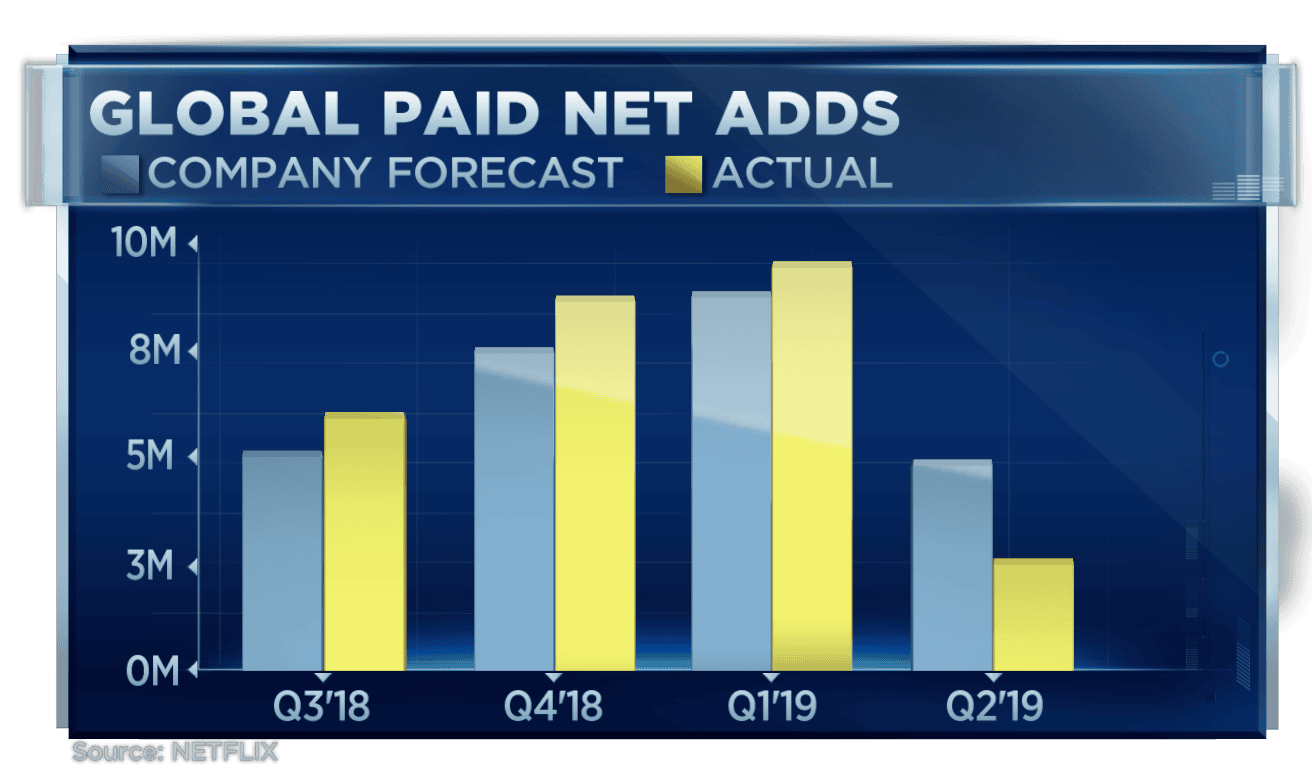
Shares of Netflix were down 10% in extended trading Wednesday after the company released its earnings report for the second quarter. The results showed a rare loss in U.S. subscribers and a large miss on international subscriber adds.
Here are the key numbers:
- Earnings per share: 60 cents, vs. 56 cents expected, per Refinitiv consensus estimate
- Revenue: $4.92 billion vs. $4.93 billion expected, per Refinitiv (Up 26% year over year.)
- Domestic paid subscriber additions: A loss of 126,000 vs. a gain of 352,000, forecast by FactSet
- International paid subscriber additions: 2.83 million vs. 4.81 million, forecast by FactSet
- Global streaming paid memberships: 151.56 million, up 21.9% year over year.
In addition to blaming its content slate for the quarter for weak subscriber growth, Netflix said its first-quarter subscriber growth was so strong that “there may have been more pull-forward effect than we realized.” The company also said in its letter to shareholders that the missed forecast was most pronounced in regions that saw price increases.
However, Netflix is projecting a stronger third quarter on the heels of heavy viewership of the third season of “Stranger Things.” Netflix forecast 7 million global paid net adds for the next quarter and provided revenue guidance of $5.25 billion. The company expects subscriber numbers will be boosted by its strong content slate in the third quarter, including the final season of “Orange is the New Black” and a new season of “The Crown.”
Before the report, shares of Netflix were up more than 35% in 2019. The stock is now set to open Thursday at its lowest price since January, shaving $20 billion from its market cap and bringing it to about $138 billion.
Netflix acknowledged it will soon lose two of its most-watched shows, “The Office” and “Friends.” NBCUniversal announced in June that it plans to remove “The Office” from Netflix in 2021 and move it to its own streaming service. Earlier this month, AT&T’s WarnerMedia announced its new streaming service, HBO Max, will include exclusive rights to stream “Friends” when it launches publicly in the spring of 2020. Netflix previously spent $80 million to keep “Friends” just through the end of this year, according to Vulture. Netflix said the loss of these shows is “freeing up budget for more original content.”
In an earnings interview released on Netflix’s investor relations site, Chief Content Officer Ted Sarandos addressed the shift in spending from licensed to original content.
“We grow through that we believe by making these early investments in original programming and getting our consumers and our members much more attuned to the expectation that we’re going to create their next favorite show, not that we’re going to be the place where you can get anything every time,” Sarandos said. “And we think there’s more value in that proposition than there would be in the kind of low price aggregator.”
Sarandos said the company will eventually share more viewership data with content creators and the public.
Even with the announcement of several new rival streaming services, Netflix told shareholders, “We don’t believe competition was a factor since there wasn’t a material change in the competitive landscape during Q2, and competitive intensity and our penetration varied across regions (while our over-forecast was in every region).”
In the earnings interview, CEO Reed Hastings said the “streaming wars” are not “a zero sum competition.”
“I’d wager that most Netflix employees are HBO subscribers,” Hastings said. “We love the content they do, and that spurs us on to want to be even better.”
The buzz around streaming has benefited the space, Hastings said.
“The advantage of having something catchy like the streaming wars is it draws more attention and because of that, consumers shift more quickly from linear TV to the streaming TV.”
Netflix said that its advertising-free model gives it an edge over several of the newer streaming entrants.
“We, like HBO, are advertising free,” the company wrote in its letter to shareholders. “That remains a deep part of our brand proposition; when you read speculation that we are moving into selling advertising, be confident that this is false. We believe we will have a more valuable business in the long term by staying out of competing for ad revenue and instead entirely focusing on competing for viewer satisfaction.”
While industry executives anticipate Netflix will someday have ads, a recent study found that 23% of respondents would definitely or probably drop their subscription if it began running ads at its current price or a dollar cheaper.
Netflix has delved into some marketing with other brands through product partnerships with Coke and Nike, among others, to promote the latest season of “Stranger Things.” Hastings said on the earnings call that the primary purpose of these partnerships is to get people to sign up for Netflix, rather than serve as another revenue stream.
“What we want to do is … keep that subscriber engine going and not get distracted with alternative revenue sources that just don’t add up when you’re growing $5 billion a year,” Hastings said.
The company maintained its free cash flow forecast for full-year 2019 of negative $3.5 billion and expects “improvement in 2020.” Beyond 2020, Netflix expects to reduce its free cash flow deficit as it grows its member base, revenue and operating margins. Netflix previously said 2019 would be its peak year for cash burn. It later revised that statement to say its cash flow would be consistent with the negative $3 billion of the prior year.
Netflix plans to continue using high-yield debt to fund content investment in the meantime, according to the shareholder letter. The company has twice offered $2 billion in debt since October. Netflix said it raised 10.5 year senior notes of 1.2 billion euros ($1.3 billion), 3.875% coupon, and $900 million, 5.375% coupon, in its latest round.

